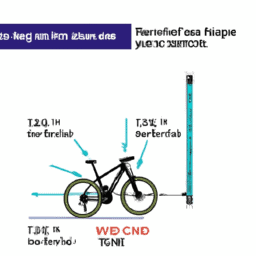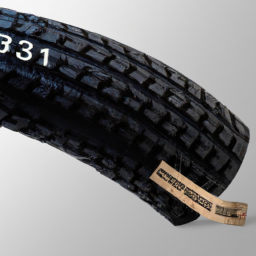Bike wheels are a critical element of every bicycle, and their durability and strength are largely determined by the materials from which they are made. A vital part of the bike wheel is the spokes. These slender, rod-shaped parts bridge the hub and the rim, offering support and stability to the wheel.
When I first started cycling, I didn’t give much thought to the spokes on my wheels. However, as I started to ride more frequently and on more challenging terrain, I realized that the quality and strength of my spokes were critical to the performance of my bike.
So, I began to research the different types of materials used for bicycle spokes and how they affect the overall performance of the bike. In this article, I’ll share what I’ve learned about what bicycle spokes are made of and how to choose the right spokes for your riding needs.
Key Takeaways
- Stainless steel is the most common material used for bicycle spokes due to its durability and corrosion resistance.
- Aluminum alloys are also used in some high-end bikes due to their lightweight property.
- Choosing the right spokes for your riding needs requires careful consideration of the terrain, intended use, and personal preferences.
- Spokes that are too loose or too tight can cause instability and safety issues, and proper maintenance and replacement of spokes are essential to keep your wheels in top condition.
The Importance of Bicycle Spokes
You might not realize it, but without strong and reliable spokes, your bicycle wouldn’t be able to handle the wear and tear of everyday use or the stress of more intense rides.
Spokes are essential components of a bicycle wheel, connecting the hub to the rim and allowing the wheel to support the weight of the rider and the bike. The importance of bicycle spokes lies in their ability to provide stability and durability to the wheel, ensuring a smooth and safe ride.
When it comes to choosing the right spokes for your bike, durability is key. The spokes need to be able to withstand the pressure and stress of the rider’s weight, as well as any impacts or bumps on the road. This is especially important for more intense riding styles such as mountain biking or racing.
The type of material used for the spokes plays a crucial role in their durability and strength. With that in mind, let’s take a closer look at the different types of materials used for bicycle spokes.
Types of Materials Used for Bicycle Spokes
Although it might seem like metal is the only option, there’s actually a wide range of materials that can be used for these crucial components.
One of the most common materials used for bicycle spokes is stainless steel. Stainless steel is known for its durability and corrosion resistance, making it an ideal choice for spokes. Spokes made from stainless steel are also relatively inexpensive and easy to produce, which is why they’re so prevalent in the market.
However, other materials are also used for spoke manufacturing techniques. For instance, aluminum alloys are also utilized in some high-end bikes. These alloys are lightweight and can be an excellent choice for racers who require a bike with the lightest possible weight.
But, the production of aluminum alloys is more complicated than stainless steel. It requires a significant amount of energy, which can have a significant environmental impact.
In the next section, we’ll delve into the properties of different spoke materials, including their environmental impact.
Properties of Different Spoke Materials
Stainless steel is not the only option for spoke materials when it comes to bicycles. Different materials have unique properties and environmental impacts that make them suitable for different riding conditions. The following table highlights the advantages and disadvantages of some of the most commonly used spoke materials, as well as their manufacturing processes.
| Material | Advantages | Disadvantages |
|---|---|---|
| Stainless Steel | Corrosion-resistant, durable | Heavy, can be stiff |
| Titanium | Lightweight, strong | Expensive, difficult to work with |
| Aluminum | Lightweight, easy to work with | Not as strong as steel or titanium, can corrode |
The manufacturing process also plays a role in determining the properties of a spoke material. For example, stainless steel spokes can be cold forged or drawn, with the latter being more expensive but resulting in a stronger spoke. Similarly, titanium spokes can be formed from a single piece of wire or machined from a solid rod, with the former being less expensive but less strong.
Choosing the right spokes for your riding needs requires careful consideration of the terrain, intended use, and personal preferences. In the next section, we will explore some factors to keep in mind when selecting the best spokes for your bike.
Choosing the Right Spokes for Your Riding Needs
Hey there, looking to upgrade your ride and want to make sure your spokes are up to snuff? Let’s dive into some key factors to consider when selecting the perfect spokes for your cycling needs.
First and foremost, you need to calculate the correct spoke length for your wheel. This can be done using an online spoke length calculator or by measuring the hub and rim dimensions yourself. It’s important to get this right, as using the wrong length spokes can result in an unstable and unsafe wheel.
Once you have the correct spoke length, you’ll need to consider the spoke tensioning techniques. Spokes play a critical role in supporting the weight of you and your bike, and ensuring that they are properly tensioned is essential for both performance and safety.
There are a variety of spoke tensioning techniques, including using a spoke tension meter or adjusting by feel. Ultimately, the technique you choose will depend on your level of experience and personal preference.
With the right spoke length and tensioning techniques, you can ensure that your ride is smooth and safe. Moving forward, it’s important to understand how to maintain and replace your spokes to keep your wheels in top condition.
Maintaining and Replacing Bicycle Spokes
To keep your wheels in top condition, it’s essential to know how to maintain and replace your spokes. One of the most important factors to consider is spoke tension. Spokes that are too loose can cause your wheel to wobble, while spokes that are too tight can cause your wheel to become brittle and break. To check the tension of your spokes, simply squeeze two parallel spokes together with your fingers. If they feel loose, tighten them with a spoke wrench until they feel snug. Conversely, if they feel too tight, loosen them until they feel more pliable.
Another important factor to consider is spoke length. If your spokes are too short, they will not provide enough support for your wheel, which can cause it to wobble and become unstable. Conversely, if your spokes are too long, they will create unnecessary weight and can cause your wheel to become unbalanced. To determine the correct spoke length for your wheel, measure the distance between the center of your hub and the rim. Then, use a spoke calculator to determine the appropriate length for your spokes. By properly maintaining and replacing your spokes, you can ensure that your wheels remain in top condition and provide a smooth, stable ride.
| Feeling | Loose | Snug | Too Tight |
|---|---|---|---|
| Spoke Tension | Needs Tightening | Good Tension | Needs Loosening |
| Result | Wobbly Wheel | Stable Wheel | Brittle and Breakable Wheel |
This table shows the importance of proper spoke tension. If your spokes are too loose, your wheel will wobble and be unstable. On the other hand, if your spokes are too tight, your wheel will become brittle and break. By keeping your spokes at the right tension, you can ensure that your wheels provide a stable and safe ride.
Frequently Asked Questions
How do you adjust the tension of your bicycle spokes?
To adjust the tension of my bicycle spokes, I use spoke maintenance techniques like the twist method or the pluck method. I ensure each spoke has equal tension, avoiding over-tightening and causing damage. Proper spoke tightening techniques prevent wheel wobbling and ensure a smooth ride.
Can you mix different types of spokes on the same bicycle wheel?
It’s important to consider spoke compatibility and strength when mixing different types of spokes on a bicycle wheel. Using incompatible spokes can lead to uneven tension and compromised strength, potentially causing wheel failure.
What is the maximum weight limit for a bicycle spoke?
The maximum weight limit for a bicycle spoke varies depending on the spoke material and design. Spoke durability is affected by factors such as spoke tension and spoke material alternatives, including steel, aluminum, and carbon fiber.
How often should you replace your bicycle spokes?
Replacing bicycle spokes is crucial for safety. Neglecting maintenance can lead to spokes breaking like a guitar string mid-performance. Signs of wear include wobbling wheels, broken spokes, and uneven tension. Don’t ignore these symptoms.
What is the history of the development of bicycle spokes?
I researched the history of bicycle spokes, focusing on innovation timeline and material selection. Spokes were initially made of wood or iron, but advancements in steel production led to the use of stainless steel and aluminum alloys.
Conclusion
So, you have it, a detailed look at what bicycle spokes are made of and why it matters. As a cyclist, it’s essential to understand the properties of different spoke materials and how they can impact your riding experience. Whether you’re a casual rider or a competitive racer, choosing the right spokes for your needs can make a big difference in performance and durability.
Interestingly, did you know that the average lifespan of a bicycle spoke is about 10,000 miles? That may seem like a lot, but for avid cyclists who log hundreds of miles each week, it’s not uncommon to need to replace spokes every few months.
Proper maintenance, including regular truing and tensioning, can help extend the lifespan of your spokes. And when it’s time for replacement, be sure to choose high-quality spokes that are appropriate for your riding style and conditions.
In conclusion, bicycle spokes may seem like a small and simple component, but they play a crucial role in the performance and safety of your bike. By understanding the materials and properties of different spoke types and taking care to maintain and replace them as needed, you can ensure a smoother, more enjoyable, and safer ride.
















